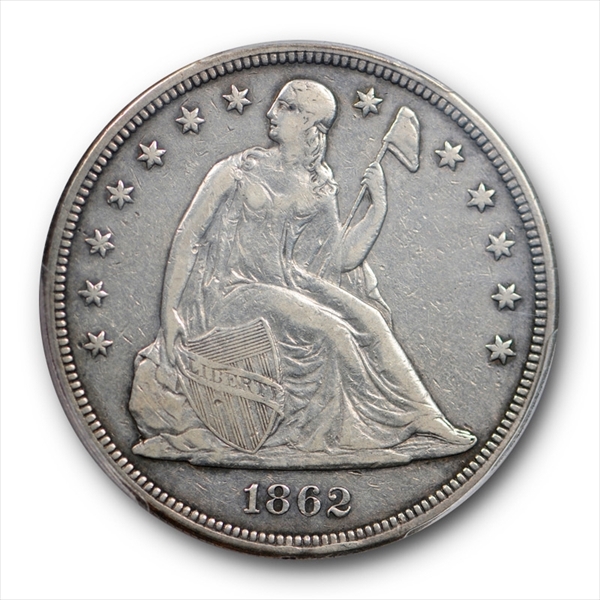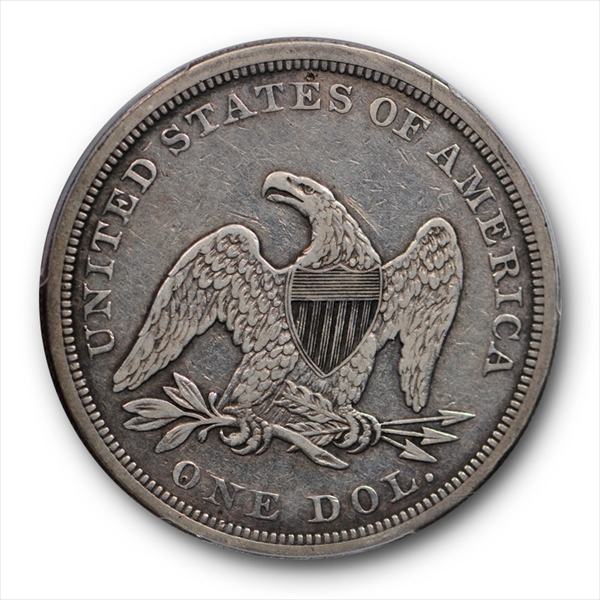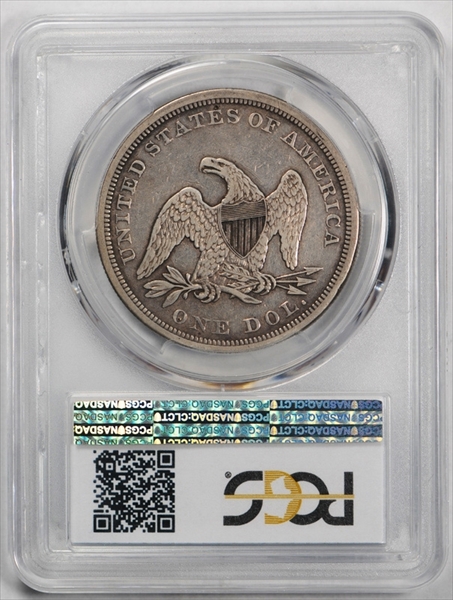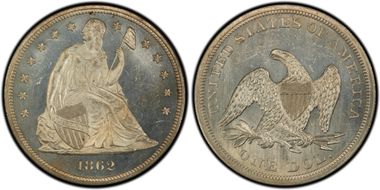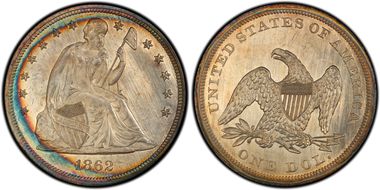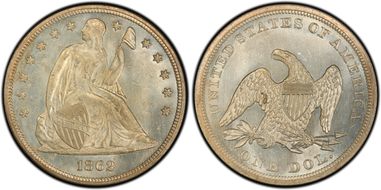1862 $1 VF30 认证号84378986, PCGS号6952
专家评论
Q. David Bowers
The following narrative, with minor editing, is from my "Silver Dollars & Trade Dollars of the United States: A Complete Encyclopedia" (Wolfeboro, NH: Bowers and Merena Galleries, Inc., 1993).Coinage Context
Silver dollars accumulate: Walter H. Breen in his Encyclopedia notes that by 1861-1862 many earlier silver dollars had accumulated in the New York Sub-Treasury and were shipped to the Philadelphia Mint for melting and conversion into subsidiary coinage. "This explains both the undue rarity of many dated 1848-1859" and a bullion source of much Philadelphia coinage 1862-1865, according to the same source.
These coins were issues which had coin back from overseas, or which had not been sold for a premium (coins 1853 and later were not distributed for face value and were held until buyers were found who were willing to pay premiums for them).
Three different dollars: In 1862, dollars had three different values in the eastern United States. Most valuable was the silver dollar, which at the time of issue was not available at par and which had a melt-down value of over $1.04 in terms of gold. Next most valuable was the gold dollar, which served as the standard against which the other dollars were measured. The gold dollar was worth $1.00 in December 1861 and by early 1862 had risen slightly due to hoarding by the public and speculators. Worth the smallest amount was the paper dollar, which soon traded at a sharp discount from both the silver and gold coins. As the Civil War progressed, the value of the paper "greenback" dollar, as it was called from the color of its reverse side, would drop below 50¢ in terms of gold and silver. It was not until December 1878 on the market, and not officially by law until January 1, 1879, that the silver dollar, gold dollar, and greenback dollar were fill freely interchangeable at the same value on the open market.
Specie payments suspended: In late 1861 the American citizenry became very jittery. In December 1861, banks suspended the payment of gold coins (specie, in government lingo). In 1862 the situation worsened. Confederate victories had caused uncertainty, it was not known which side would be the victor in the Civil War, and all kinds of coins began to be hoarded. By the second week of July, scarcely a dime, quarter, or any other coin was to be seen, a situation which caused great consternation among tradesmen and vendors. Small cardboard chits and other coin substitutes sprang up and were widely used, as were a later spate of encased postage stamps, bronze tokens (called Civil War tokens by collectors today), scrip, and other paper currency notes. The Treasury suspended the payment of silver coins.
From the summer of 1862 onward, the Philadelphia and San Francisco mints turned out a steady but small quantity of silver coins which were not used in the eastern part of the United States. However, many of these went to Canada, where they circulated as fractional silver pieces and were literally as good as gold. An estimated $30 million worth of earlier silver coins found their way to Latin America, where in some instances United States coins traded at a premium. The West Indies, the East Indies, and the Orient provided additional markets. Curiously, all throughout the Civil War, gold and silver coins circulated readily on the West Coast. The explanation is that the West Coast had abundant supplies of gold and silver, and transportation with the East was such that monetary differences could not be adjusted quickly (the transcontinental rail link was not completed until years later, in 1869).
Concerning the withdrawal of silver and gold coins from circulation, Hepburn (p. 204) states that there was an estimated $250 million in specie in circulation in 1861, but only $25 million at the close of 1862, that "only the amount estimated in use on the Pacific slope."!
As they were worth more than face value even before the suspension of specie payments, Liberty Seated dollars did not circulate in the United States at any time during 1862. Over a decade later, in autumn 1876, following the acts of January 14, 1875 and April 17, 1876, specie payments were resumed, and the Treasury released quantities of coins of earlier dates. By this time the value of silver had fallen on world markets, due to the actions of Germany in Europe and the immense outpouring of silver from the Comstock Lode in the United States, and Liberty Seated dollars were no longer worth more as bullion than his coins. Thus, for the first time since early 1853, Liberty Seated coins of the dollar denomination were seen in general circulation.
Numismatic Information
Circulated grades: Although the 1862 silver dollar was minted in low quantities-just 11,540 business strikes were made-a fair number have survived to the present day. Although quite rare, the 1862 is not "impossible" and, in fact, is more easily obtained than the higher mintage 1861. Per Director Pollock's 1861 comment, quoted earlier, by 1862 there was a diminished demand for silver dollars for export to China. Probably, many remained stateside and were placed into circulation after the mid-1870s, by which time their bullion value had fallen to below face value. Alert bank tellers and others fished dozens of specimens out of circulation in the 1890s and the following decade.
Mint State grades: In Mint State the low-mintage 1862 is rare, and is especially so in MS-64 or better. High-grade coins typically have extensive die striae, as struck, on the obverse and reverse, making it appeal' to the uninitiated that such coins have been cleaned or brushed. On the obverse, the die striations are diagonal and are oriented in a line, more or less, with the top of Miss Liberty's lower left leg. On the reverse, the die striations are nearly vertical.
As is the case with other Liberty Seated dollars after 1858, the relative availability of Proofs takes much of the demand away from Mint State coins. Because of this Proof factor, the true rarity of Mint State Liberty Seated coins was not recognized in the literature until recent decades," Since the founding of the Liberty Seated Collectors Club in 1974 there has been a great interest in the subject. This and the availability of PCGS. and NGC population reports have made it possible to appreciate such coins today for the rarities that they truly are.
Varieties
Business strikes:
1.Normal Date: Breen-5468. One obverse and two reverse dies were prepared for business strike coinage. Mint State pieces have heavy die striations in the fields.
Dies prepared: Obverse: 1; Reverse: 2
Business strike mintage: 11; 540; Delivery figures by day: February 4: 700; June 24: 500; July 30: 5,000; August 5: 5,340.
Estimated quantity melted: Unknown Approximate population MS-65 or better: 2 to 4 (URS-2)
Characteristics of striking: Most are well struck. Known hoards of Mint State coins: None
Commentary
This date is remarkable for its low business strike mintage of just 11,540 pieces.
U.S. Silver Coins Go to Canada
In July 1862, private holders of silver coins, including banks and bullion brokers, sent these pieces (not including Liberty Seated dollars) in huge quantities to New York City, where they were sold at premiums. From that point, untold numbers went to Canada, where for the next decade they constituted what one writer called the "American silver nuisance." It was estimated that in Montreal alone, during the next several years, not less than $80,000 worth of American silver coins changed hands per day, and at least 30 money brokers derived the majority of their income by participating in such transactions.
(Weir, Sixty Years in Canada, pp. 137, 138, 159, 167.)
The Canadian government passed legislation which provided that after April 15, 1870, the legal rate of United States silver coins in Canada would be 80 cents on the dollar, an action intended to encourage exportation before that date. However, on the market the price did not dip below 95 cents on the dollar, due to demand for the coins from money brokers. Eventually, over $5 million worth of U.S. quarters and half dollars and about $500,000 worth of lower-denomination silver coins were shipped back to the United States in 1870. Apparently, no silver dollars were included-a testimony (as if one were needed) that no Liberty Seated dollars were in American circulation when the flight of coins from New York began in 1862.
PCGS #
6952
设计师
Christian Gobrecht
边缘
Reeded
直径
38.10 毫米
重量
26.73 克
铸币数量
11540
金属成分
90% Silver, 10% Copper
更高评级数量
171
评级较低的钱币数量
20
地区
The United States of America
价格指南
PCGS 数量报告
拍卖 - PCGS 评级的
拍卖 - NGC 评级的
稀有性和存量估计 了解更多
| 所有评级 | 1100 |
| 60或以上 | 100 |
| 65或以上 | 3 |
| 所有评级 | R-4.9 |
| 60或以上 | R-8.0 |
| 65或以上 | R-9.8 |
| 所有评级 | 5 / 30 TIE |
| 60或以上 | 19 / 30 TIE |
| 65或以上 | 13 / 30 TIE |
| 所有评级 | 12 / 45 TIE |
| 60或以上 | 28 / 45 TIE |
| 65或以上 | 15 / 45 TIE |




















